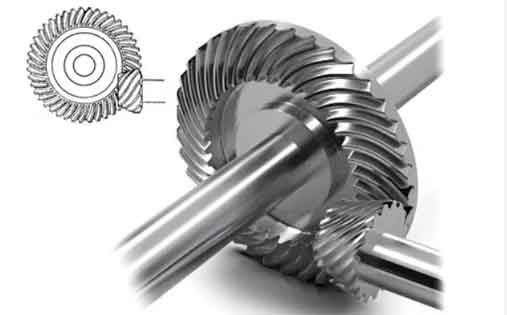The evolution of spiral bevel gear production can be broadly understood by examining its past developments, present technologies, and future trends. This journey highlights significant technological advancements, shifts in manufacturing practices, and expectations for the industry’s progression.

Past
Historically, the production of spiral bevel gear was a highly specialized and labor-intensive process, requiring skilled craftsmen to manually set up machines and cut gears. The early 20th century saw the introduction of mechanical calculators and specialized machinery designed to cut spiral bevel gear, which started to standardize the manufacturing process. These advancements allowed for more consistent quality and slightly higher production rates, but the process remained relatively slow and required significant manual input.
During the mid-20th century, further developments in machine tool technology and the introduction of computer numerical control (CNC) systems began to transform spiral bevel gear manufacturing. CNC machines allowed for more precise control over the cutting process, improving the consistency and quality of spiral bevel gear produced. This period also saw the development of specialized software for designing spiral bevel gear profiles and simulating their performance, enabling more complex and efficient gear designs.
Present
Today, spiral bevel gear production is highly automated and relies on advanced CNC machinery and computer-aided design (CAD) and manufacturing (CAM) software. These tools allow for precise control over the manufacturing process, from initial design to final production, significantly reducing the need for manual adjustments and increasing production speed and efficiency.
Modern manufacturing techniques such as additive manufacturing (3D printing) are beginning to find applications in spiral bevel gear production, allowing for the creation of complex geometries that were previously difficult or impossible to achieve. This not only opens up new possibilities in spiral bevel gear design but also reduces waste material and can potentially shorten production times.
Quality control has also seen significant advancements, with the use of computer-aided inspection (CAI) and other digital measurement techniques ensuring that spiral bevel gear meet strict tolerances and performance specifications.
Future
The future of spiral bevel gear production is likely to be shaped by further advancements in manufacturing technology, particularly in the areas of additive manufacturing, artificial intelligence (AI), and machine learning. These technologies could lead to more automated and intelligent manufacturing processes, where machines can adapt to changes in the production environment or the condition of the material being worked on, optimizing the production process in real-time.
Sustainability and environmental considerations are also expected to play a larger role, with a focus on reducing energy consumption, minimizing waste, and using more environmentally friendly materials and processes.
In addition, as the demands on spiral bevel gear continue to increase, with applications requiring higher durability, lower noise, and greater efficiency, the development of new materials and coatings will also be critical. These advancements will allow spiral bevel gear to operate under more extreme conditions, opening up new applications and further driving the evolution of spiral bevel gear production technologies.
In summary, the production of spiral bevel gear has evolved from a manual and labor-intensive process to a highly automated and technologically advanced one. The future promises even greater advancements, with the potential for more intelligent, sustainable, and efficient manufacturing processes.
